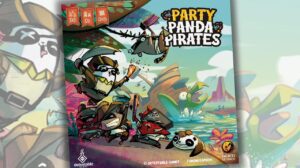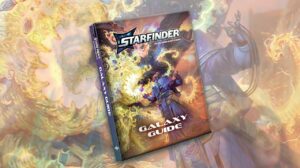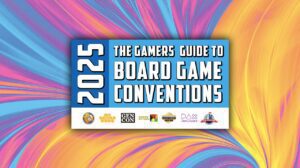Disclosure: Meeple Mountain received a free copy of this product in exchange for an honest, unbiased review. This review is not intended to be an endorsement.
Whenever a bright and shiny new abstract game is released, people immediately begin comparing it to the 2017 juggernauts: Azul and Sagrada. It’s difficult to peddle abstract games, because their themes are generally plastered over the top of the mechanics, so publishers and designers have to get creative by upping the visuals and production value to get gamers to bite. INK is the latest contender in the abstract board game space, showcasing beautiful acrylic ink bottles and printed cloth bags. But does it have staying power? Let’s find out.
INK Overview
INK—whose name is in all caps on BGG but completely lowercase on the cover—features players moving their Lead ink bottle around a rondel to acquire tiles. These tiles are then placed on their personal tableaus adjacent to at least one matching color to create a sprawling painting of spilled ink. Completing Objectives reduces a player’s bottle supply, and whoever places all of their bottles first is declared the winner.
Each player receives a Palette card, which outlines the two colors that they will generally need to focus on. When completing Objectives, you’ll always want to use Palette bottles matching the color of your objective first—since they’re more restrictive—before using the Joker bottles that can be placed on any color.
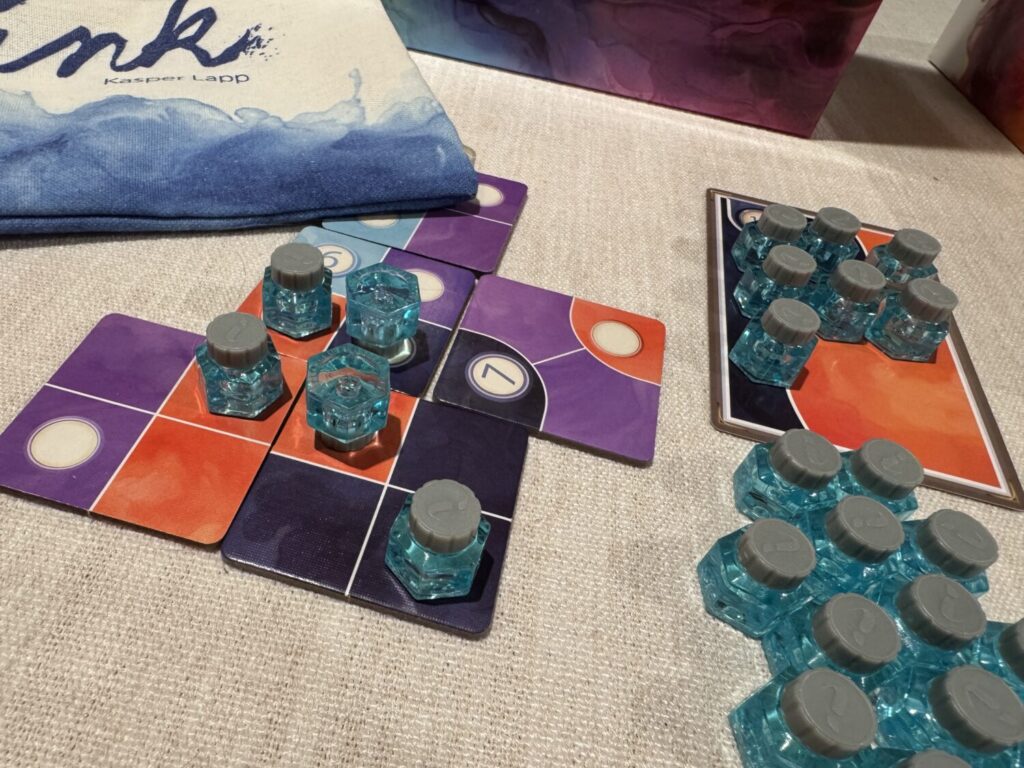
The game is set up with six random tiles arranged along the edge of the Quill wheel. In a rondel style, the active player moves their ink bottle to a space corresponding to a tile that they’d like to take. In this way, any of the tiles are available for selection, but crossing the starting space of the Quill wheel forces the draw of a random X token. These tokens cover up a portion of your placed tiles, cancelling out spaces and disconnecting your color groupings, so it’s a way to penalize players who have no reservations about whipping around the wheel.
Once your selected tile is placed, you can optionally complete any Objectives, which are the circled numbers featured on some of the tiles. If a colored area has at least as many adjacent matching squares as the Objective number—and you have remaining Joker bottles or matching Palette bottles—then you can complete the Objective. You place one bottle upside down on the Objective, marking it as immovable, and then place bottles on any other blank dots in that colored section.
The other benefit of completing Objectives is that you trigger Bonus Actions. If you’re playing with the recommended first-time setup, these get increasingly better as your Objective number increases, allowing you to take another tile from the bag and play it immediately. There are 12 Bonus Actions available for the four spaces during any given game, affording an extra bit of modularity to games of INK.
In some rare cases, you might not want to grab a tile from the Quill wheel, in which case you can Pass. In a game that typically comes down to the wire, this can be a costly decision. But it does allow you to convert up to two Palette bottles to Joker bottles, which can be necessary in a pinch.
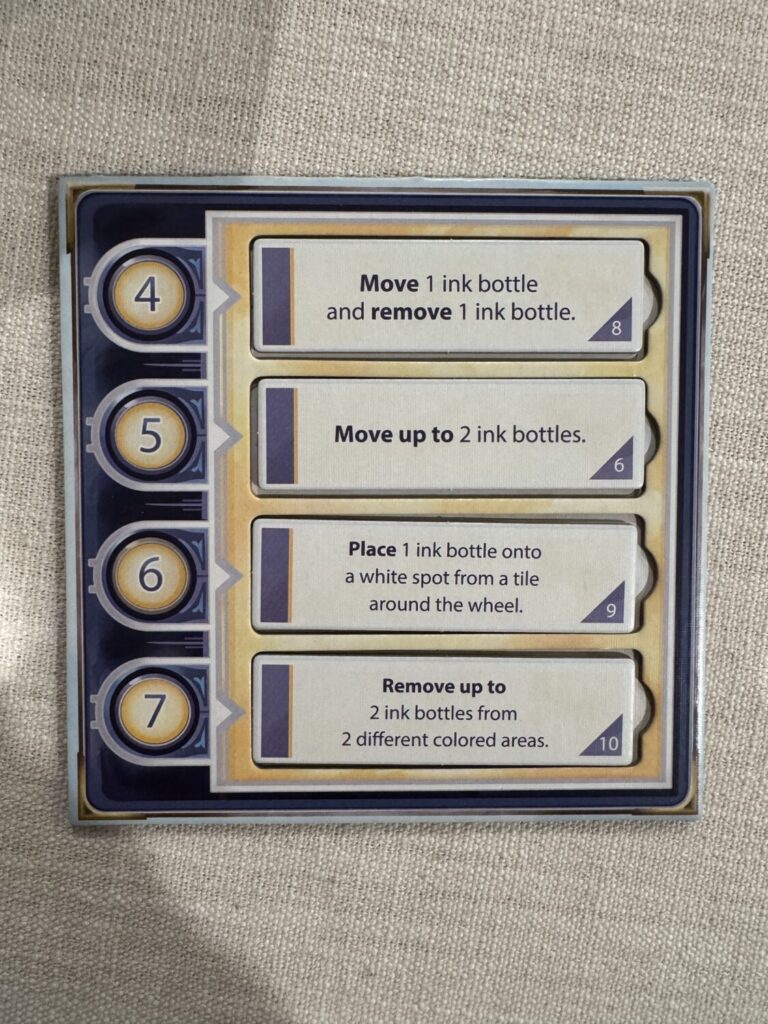
INK: Drawing Conclusions
From a production standpoint, INK is a grand slam. Solid, thick tiles, a double-layered Bonus Action board, and high-quality cloth bags with ribbon fasteners are enough to give any game high praise in this category. But then you add in the gorgeous little acrylic ink bottles and that’s what really turns heads at conventions and social gatherings. If I could make one aesthetic change, it would be to swap out the more mundane gray on the bottle caps to be something more flashy, like a matte silver or the like, but that’s just me looking for something to critique at this point.
Over the course of several two-player games of INK, I’ve found it to be a rather tight race between the competing parties. Even if it seems like one player is rapidly depleting their bottle stock faster than the other, the comboing and chaining potential can even the scores relatively quickly. Looking ahead at the Quill wheel and careful planning can lead to explosive turns, so you never feel safe with a lead.
If you end up using up your final bottles and you could have placed more, there is a reserve of generic black ink bottles that you can dip into and use, which becomes important if both players run out of their respective bottles during back-to-back turns to end the game. At that point, whoever used more generic bottles wins.
The Quill wheel feels like a perfect pacing element. There are just enough tiles to give you adequate choice and to prevent you from having a dud turn where you’re forced to pick a tile that doesn’t really fit well into your plans. But in doing so, you may need to cross that dreaded starting space and get an X token.
X Tokens are brutal. They are color restrictive, which means that your random draw could force you to place the token over your only instance of a color instead of allowing you more choice in how you become hampered. It doesn’t seem like they would create much extra tension, but I feel a palpable dread every time I reach my hand into the bag to grab one. Crossing the threshold to grab that perfect tile requires you to be mindful that the tile may not be so perfect by the time you place it.
I also appreciate that some tiles have opposite corners connected with the same color, forming the loose shape of a fountain pen nib. Not only is this a pleasing aesthetic choice, but it actually opens up the game for many more opportunities for big turns. It allows you to connect independent groupings of like-colors together more easily as you create your masterpiece.
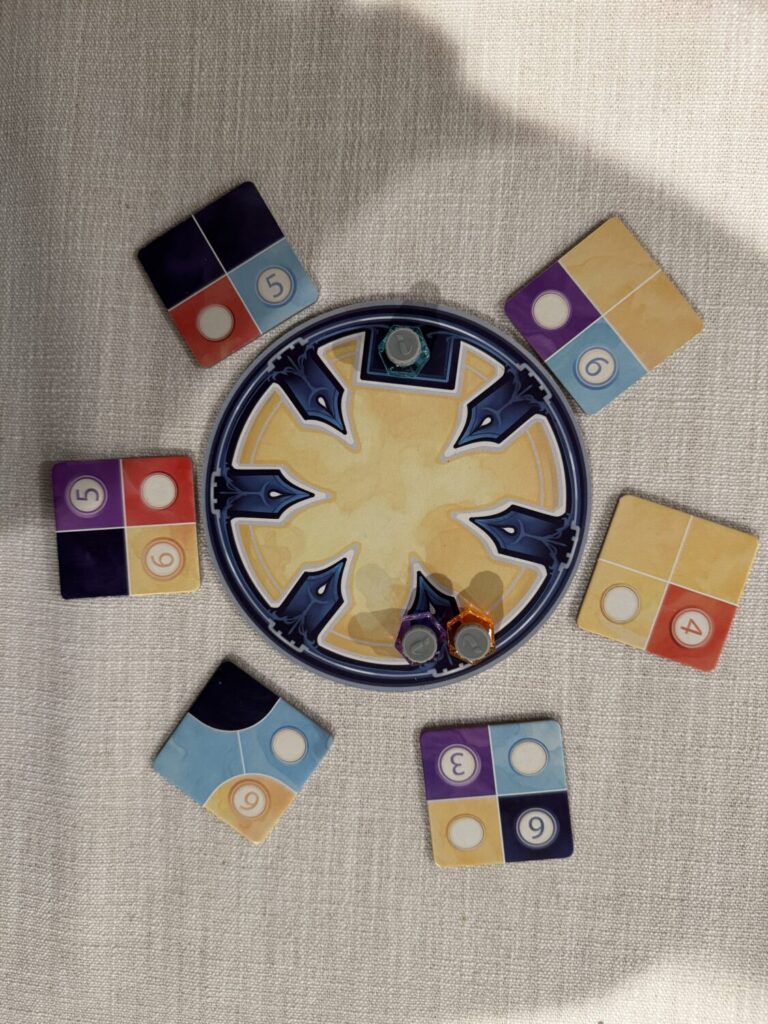
Over the years, I thought that I didn’t care for games that allowed for players to build free-form tableaus—such as INK or Akropolis—without space restrictions that you might see in games like Kingdomino. How big of a table am I going to need to play this game if everybody is careening towards the edges? However, I’ve come around on that line of thinking and accept that unbounded tableaus grant opportunity for creative play. A straight line of tiles in INK isn’t going to be a solid strategy, but I’ve seen winners with confined paintings and others with amoeba-esque paintings. It’s all about leveraging your tiles to the best of your ability.
Does INK stack up to other abstract giants? Definitely. There’s plenty of strategic choice available, down-to-the-wire scoring potential, and a beautiful package to hold it all together. After my first play, I immediately wanted to play it again, and found myself playing ten times over the course of a week. Although I don’t necessarily find the thematic reasoning for playing bottles of ink on top of my painting before it’s finished, the gameplay is enough to keep it on the shelf.
And I’ll stand behind those words, immortalizing them forever in digital ink.




